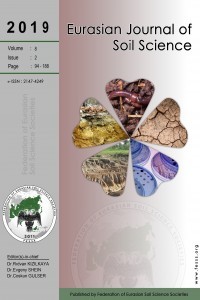
Eurasian Journal of Soil Science
Yazarlar: Magboul Sulieman, Abd El-Azeem Sallam
Konular:Fen
DOI:10.18393/ejss.2016.4.322-331
Anahtar Kelimeler:Gypsiferous soils,Al-Ahsa governorate,Disaggregation methods,Sonication
Özet: Until now, there is no method can be used to accurately assess the particles size distribution as well as textural classes of gypsiferous soils for proper interpretation of physical behavior of these soils, and most laboratory methods involve pretreatment to remove gypsum from the samples. Therefore, the results of the particle size distribution do not reflect the size distribution of the whole soil. This study aimed to develop an alternative method to determine particle size distribution for some gypsiferous soils selected from Al-Ahsa governorate, Saudi Arabia. Five samples from different profiles with different gypsum content were selected to evaluate the modified method. Sand fractions were separated with three disaggregation methods: 1) drying sieving, 2) shaking for 5 hours in a 7:3 ethanol: water solution, and 3) sonication for 3 minutes in a 7:3 ethanol: water solution. The statistical analysis results revealed that the sonication for 3 minutes in a 7:3 ethanol: water solution was the most effective method for separating sand fractions as compared to dry sieving and shaking. Meanwhile, there was slight difference in separating sand fractions between sonication for 3 minutes and shaking for 5 hours. The particle size distribution by the developed method showed increasing in total sand content as compared to standard particle size method. Likewise, comparison of the CEC/clay ratio between the two methods also indicated that the developed method yielded clay contents more consistent with other property data for the same horizons. Consequently, the textural classes obtained from the two methods were different. Therefore; we concluded that the determination of particle size distribution for gypsiferous soils (≤ 40% gypsum) using this developed method will improve the understanding and ability to proper interpret of physical behavior of these unique soils. We highly recommended using this developed method to separate soil particles from the gypsiferous soils.